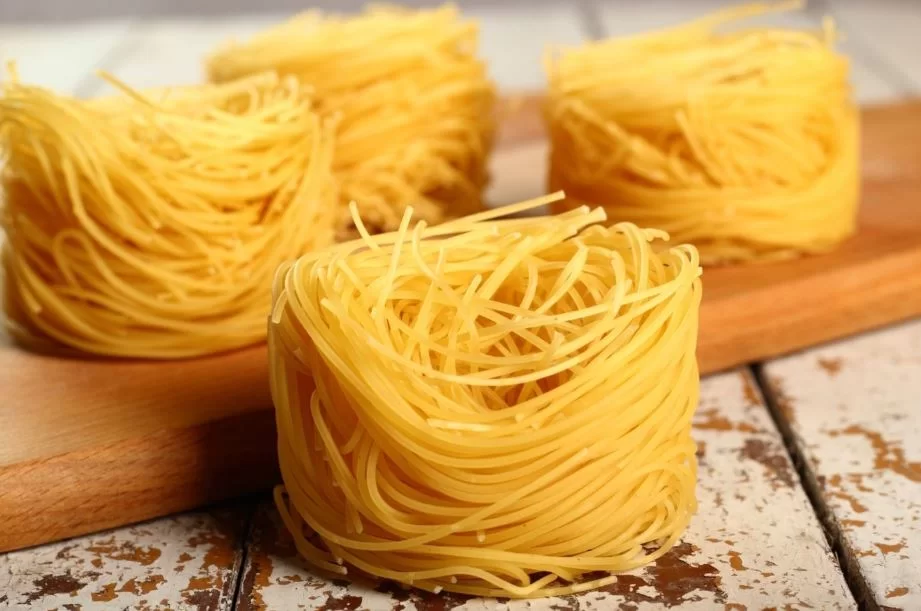Italian cuisine is a world of indulgent flavors and time-honored traditions, with each pasta shape offering its own unique experience. Among these beloved classics is tagliolini, a delicate, thin pasta with deep roots in Italian culinary history. Tagliolini, closely related to tagliatelle but thinner, is cherished for its lightness and ability to elevate simple ingredients to gourmet status. Whether paired with rich truffle sauce, seafood, or a simple butter and herb finish, tagliolini is a versatile dish that impresses both home cooks and professional chefs alike.
What is Tagliolini?
Tagliolini is a variety of ribbon pasta, thinner than its cousin tagliatelle, yet thicker than angel hair pasta. It’s a long, flat noodle typically made from a combination of egg and semolina flour. Its fine texture makes it ideal for delicate sauces, allowing for a perfect balance between pasta and accompanying flavors. Originating from northern Italy, particularly in regions like Piedmont and Emilia-Romagna, tagliolini is often served in elegant, minimalist dishes that let the pasta shine.
Unlike heavier pastas that require rich sauces to stand out, tagliolini pairs best with lighter, more refined ingredients, such as butter, truffle, or fresh seafood. Its texture, which is firm yet tender when cooked correctly, provides a delightful mouthfeel that makes every bite memorable.
The Origins of Tagliolini
The roots of tagliolini can be traced back to the culinary traditions of Northern Italy, where pasta-making was an art passed down through generations. While pasta-making has ancient origins, tagliolini is believed to have evolved in regions that valued thin, delicate pastas to complement the local, refined ingredients. In Piedmont, for example, tagliolini is traditionally served with butter and shaved white truffle—a simple yet luxurious dish.
This pasta’s delicate nature is a reflection of Italian cuisine’s ability to turn humble ingredients into something extraordinary. Despite its seemingly simple ingredients, tagliolini is a pasta that celebrates craftsmanship, skill, and precision, requiring the perfect balance of flour, eggs, and technique.
How to Make Homemade Tagliolini
Making tagliolini at home may seem like an ambitious project, but with the right technique and patience, it can be an incredibly rewarding experience. Homemade tagliolini has a fresher, more tender texture compared to store-bought varieties, allowing the natural flavors of the ingredients to shine through.
Ingredients for Homemade Tagliolini:
- 2 cups semolina flour
- 3 large eggs
- A pinch of salt
- A drizzle of olive oil (optional)
Instructions
- Mix the Dough: On a clean surface, make a mound of flour and create a well in the center. Crack the eggs into the well, add a pinch of salt, and start to whisk the eggs with a fork, slowly incorporating the flour into the mixture. Once the dough starts to come together, use your hands to knead it into a smooth ball. If the dough is too dry, add a few drops of water; if it’s too wet, sprinkle more flour.
- Kneading: Knead the dough for about 10 minutes until it becomes smooth and elastic. Wrap the dough in plastic wrap and let it rest for at least 30 minutes at room temperature.
- Rolling and Cutting: Once rested, divide the dough into manageable portions. Roll each portion out with a rolling pin or use a pasta machine, gradually reducing the thickness until the dough is paper-thin. Once you have the desired thickness, cut the pasta into thin, long strips (about 2-3mm wide).
- Cooking: Fresh tagliolini only needs to cook for 2-3 minutes in boiling salted water. It’s essential to keep a close eye on it to avoid overcooking.
Homemade tagliolini is perfect when served with light, aromatic sauces or dressed with high-quality olive oil and fresh herbs.
Popular Tagliolini Recipes
Tagliolini with Truffle Butter
Tagliolini is perhaps most famous when paired with truffle, a luxurious ingredient that brings out the best in this pasta. The earthiness of the truffle perfectly complements the delicate texture of the noodles, resulting in an unforgettable dish.
Ingredients
- Fresh tagliolini pasta
- 50g butter
- Shaved black or white truffle (according to taste)
- Grated Parmesan cheese
- Salt and pepper to taste
Instructions
- Cook the tagliolini in salted boiling water for 2-3 minutes, then drain.
- In a saucepan, melt the butter over low heat, then add the cooked pasta.
- Toss gently to coat the pasta in butter.
- Serve with freshly shaved truffle and a sprinkle of Parmesan cheese.
This recipe highlights the natural flavors of the truffle without overwhelming the delicate pasta. A simple, elegant dish that’s perfect for special occasions.
Tagliolini with Seafood and White Wine
Another popular pairing for tagliolini is seafood. The light texture of the pasta works harmoniously with shellfish and other seafood, creating a dish that feels both refreshing and satisfying.
Ingredients
- Fresh tagliolini pasta
- 200g mixed seafood (shrimp, mussels, clams, etc.)
- 2 cloves garlic, minced
- 1/2 cup white wine
- 2 tbsp olive oil
- Fresh parsley, chopped
- Salt and pepper to taste
Instructions
- Cook the tagliolini in salted water, then drain.
- In a large pan, heat the olive oil and sauté the garlic until fragrant.
- Add the seafood and cook until done, then deglaze the pan with white wine.
- Toss the pasta in the pan with the seafood and sauce.
- Garnish with fresh parsley and a squeeze of lemon.
This dish is a perfect representation of coastal Italian flavors, light yet rich in taste.
Tagliolini with Truffle: A Culinary Luxury
Tagliolini with truffle is one of Italy’s most revered dishes, often served in fine dining establishments. The silky texture of the pasta pairs beautifully with the umami depth of truffles, creating a dish that feels decadent yet simple. White truffles, in particular, are sought after for their rarity and intense flavor. In regions like Alba, this dish is a staple during truffle season.
Though truffles are often considered a luxury ingredient, this dish highlights the philosophy of Italian cuisine: letting a few high-quality ingredients speak for themselves.
Pairing Wines with Tagliolini
The perfect wine pairing for tagliolini depends largely on the sauce and ingredients used in the dish. For a butter or truffle sauce, a white wine such as Chardonnay or Gavi works beautifully, offering a buttery richness that complements the earthiness of the truffle. On the other hand, seafood tagliolini pairs well with crisp, dry whites like Pinot Grigio or Sauvignon Blanc, which enhance the freshness of the seafood.
When selecting a wine, it’s essential to consider the subtle flavors of the pasta and ensure the wine complements rather than overpowers the dish.
Cooking Tips for Perfect Tagliolini
Achieving the perfect texture for tagliolini requires a balance of technique and timing. Here are a few tips to ensure your pasta turns out flawless every time:
- Don’t Overcook: Fresh tagliolini cooks much faster than dried pasta. Keep a close eye on the pot, as it can go from al dente to mushy in a matter of seconds.
- Use Plenty of Salt in the Water: Salting your pasta water is crucial to enhancing the flavor of the noodles. The water should taste like the sea.
- Toss the Pasta in the Sauce: Rather than pouring sauce over your pasta, always toss the noodles in the sauce to ensure each strand is evenly coated.
Conclusion
Tagliolini is a quintessential Italian pasta that represents the elegance and simplicity of traditional Italian cooking. Whether you’re enjoying it with the luxurious taste of truffle or the fresh flavors of seafood, tagliolini offers a culinary experience that is both refined and satisfying. With its rich history, versatile recipes, and ease of preparation, tagliolini is a dish that belongs in every pasta lover’s repertoire.
Frequently Asked Questions
What is the difference between tagliolini and tagliatelle?
Tagliolini is thinner than tagliatelle, with a more delicate texture, making it ideal for lighter sauces. Tagliatelle is wider and sturdier, suitable for hearty, meaty sauces like Bolognese.
Can I make tagliolini without a pasta machine?
Yes, while a pasta machine makes the process easier, you can roll out the dough with a rolling pin. Just be sure to roll it thin enough to create the delicate, thin strands characteristic of tagliolini.
How should I store fresh tagliolini?
Fresh tagliolini can be stored in the refrigerator for up to two days, or it can be frozen for up to a month. Be sure to dust the pasta with flour to prevent sticking before storing.
What is the best sauce for tagliolini?
Light sauces such as butter, olive oil, or a simple seafood sauce work best. Truffle butter is a classic pairing that highlights the pasta’s texture and flavor.
Is tagliolini gluten-free?
Traditional tagliolini is made with wheat flour, which contains gluten. However, gluten-free versions can be made using alternative flours like rice flour or chickpea flour.
Can I use dried tagliolini instead of fresh?
Yes, dried tagliolini is available and can be used in most recipes. However, the texture and flavor won’t be as delicate and fresh as homemade tagliolini.











